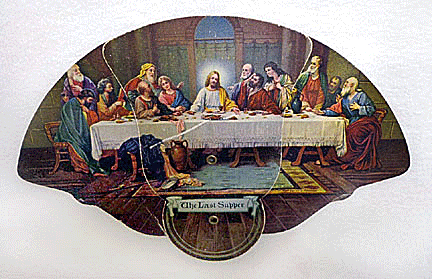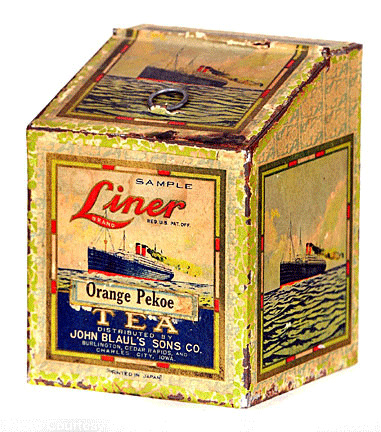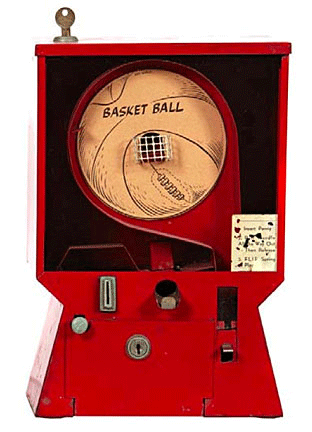Getting the Word Out
by Bob Brooke
 In
ancient towns and cities most citizens were illiterate, so town-criers
got the word out by calling out official announcements and general news.
At the same time, itinerant hawkers walked the streets, crying out to
passersby about their goods and services. In
ancient towns and cities most citizens were illiterate, so town-criers
got the word out by calling out official announcements and general news.
At the same time, itinerant hawkers walked the streets, crying out to
passersby about their goods and services.
The first written advertisement dates back to a papyrus from 3,000 BCE
in Thebes, Egypt. A slaveholder, trying to find his runaway slave, also
promoted his weaving shop. While the form may have changed over the
centuries, the intent has not.
Sellers in ancient times verbally advertised their products in the
marketplace. Later, they found carved signs worked better and sales
increased. Today, advertising takes many forms, from print to display to
promotional items.
The Printing Press Changed Things
Newspapers and magazines began printing advertisements in the 16th and
17th centuries. The first weekly gazettes appeared in Venice in the
early 16th-century. From there, the concept of a weekly publication
spread to Italy, Germany and Holland. In Britain, the first weeklies
appeared in the 1620s, and that country's first daily newspaper, The
Daily Courant ran from 1702 to 1735. The ads that ran in these papers
were usually for quack medicines but the variety of products promoted
soon grew.

On this side of the Atlantic, the first newspaper advertisement appeared
in 1704. Then in the early 1800s, billboards came into existence and
brands began to use them to promote the value of their products.
Advances in printing allowed retailers and manufacturers to print
handbills and trade cards. The earliest trade cards weren’t cards at
all, Instead, printers produced them on paper and didn’t include
illustrations. By the 18th century, however, printers began cranking
them out on more substantial card stock which typically bore the
tradesman's name and address. Before street numbering came into common
use, trade cards often included long-winded sets of directions on how to
locate the store or premises. With the advent of commercial engraving
and lithography, illustrations became a standard feature of even the
most humble trade card. Eventually, trade cards evolved into business
cards, which businesses still use today.

Business owners in the 19th century considered direct advertising, which
reached out directly to potential customers, but it was expensive. Many
businesses instead preferred indirect advertising because it was more
affordable. It dealt more with promoting a product or service rather
than the business, itself— for example, a large poster in the window of
a shop.
Sears became the first company to focus more on direct advertising when
they launched their first direct mail campaign in 1892. The company
posted more than 8,000 postcards that generated 2,000 new orders. This
encouraged other organizations to increase their advertising budgets.

But advertising took a whole new turn when radio stations and television
appeared on the scene. By the beginning of the 20th century, more than
30 percent of people around the world used them. At this time, ads began
to feel more personalized, as communication now occurred directly
between the customer and the brand.
In 1922, the first radio ads hit the airwaves. But it wasn’t until 1941
that 4,000 consumers first viewed a 10-second ad for the Bullova Watch
Company on television. That sparked the Golden Age of Advertising in
which businesses invested heavily in advertisements to promote their
brand’s uniqueness while engaging their target audience.
 In the 1950s, brands started introducing characters just so
advertisements would resonate with their audiences. For example,
Kellogg's introduced cartoon mascot Tony the Tiger to promote Frosted
Flakes breakfast cereal. Many brands started focusing more on increasing
their brand awareness with advertising instead of being strictly focused
on sales.
In the 1950s, brands started introducing characters just so
advertisements would resonate with their audiences. For example,
Kellogg's introduced cartoon mascot Tony the Tiger to promote Frosted
Flakes breakfast cereal. Many brands started focusing more on increasing
their brand awareness with advertising instead of being strictly focused
on sales.
 But
there’s always been a major difference between advertising and
promotion. Advertising has always been a one-way communication whose
purpose has been to inform potential customers about products and
services and how to obtain them. Promotion, on the other hand, has
always involved distributing information about a product, brand, or
company. Promotions usually last for a specific time period while
advertising generally lasts longer. But
there’s always been a major difference between advertising and
promotion. Advertising has always been a one-way communication whose
purpose has been to inform potential customers about products and
services and how to obtain them. Promotion, on the other hand, has
always involved distributing information about a product, brand, or
company. Promotions usually last for a specific time period while
advertising generally lasts longer.
Promotional items have long held a premier place in the advertising
realm in America. The first promotional item in U.S. history was a
commemorative button made for George Washington in the election of 1789.
Due to the success of his campaign, promotional items like almanacs,
calendars, rules, and wood specialties slowly became available.
Historians credit Jasper Meek as the father of the promotional products
industry. In the late 1800s, Meeks was a newspaperman who wanted to keep
his presses running during slow times. He then started printing burlap
bags with advertising messages. A local shoe store then gave them to
school children to promote his business.

Promotional products have come a long way since Washington’s election
button. Over the last 100 years or so, items like funeral fans, pens,
beverage serving trays, coffee mugs, and matchbook covers have carried
messages about one product or another out to the public.
The Allure of Advertiques
 “Advertiques,”
or objects with some sort of advertising, are popular with collectors.
It’s not unusual for collectors to pay big bucks for some of the larger
and rarer items. And the variety of objects available is great, enabling
collectors of every financial level to assemble a fine collection. “Advertiques,”
or objects with some sort of advertising, are popular with collectors.
It’s not unusual for collectors to pay big bucks for some of the larger
and rarer items. And the variety of objects available is great, enabling
collectors of every financial level to assemble a fine collection.
Manufacturers in the 19th century couldn’t resist employing useful items
to promote their products, for at the time, promoting products was the
key, unlike today where promoting the benefits to consumer is more the
style. String holders, ashtrays, fans—all served as a promotional
medium.

 Advertising
wasn’t limited to just trade cards, posters, and signs, originally used
to advertise a business. Objects, like coffee mills, flour and coffee
bins, and gum and candy machines, on the other hand, promoted a product.
All were necessary to the functioning grocery or dry goods store of the
late-19th and early 20th centuries. Advertising
wasn’t limited to just trade cards, posters, and signs, originally used
to advertise a business. Objects, like coffee mills, flour and coffee
bins, and gum and candy machines, on the other hand, promoted a product.
All were necessary to the functioning grocery or dry goods store of the
late-19th and early 20th centuries.
One reason collectors like these “advertiques” is that advertising is a
vital part of doing business today. With other types of antiques, both
the object and its function are now obsolete. But the advertising
techniques used by business have changed very little since the late 19th
century. Posters, free samples, and mass advertising are still in as
much use today as they were over 125 years ago.
One of the most widely collected form of promotion was the advertising
poster. These first appeared in the late 18th century as black-and-white
woodcuts. But the introduction of lithography in the 1850s led to a
proliferation of brightly colored tin and paper posters.

While most people probably couldn’t recall any 19th-century advertising
poster, there’s one that older people still remember from their
childhood—the circus poster. Color lithography helped to spread the news
of upcoming shows across the country.
 Trade
cards were miniature versions of advertising posters. Business owners
paid small boys a few pennies to hand these out to passersby. These
cards urged to recipient to a product, such as a cologne, or a patent
medicine, or directed him or her to a specific store that sold the
product. Trade
cards were miniature versions of advertising posters. Business owners
paid small boys a few pennies to hand these out to passersby. These
cards urged to recipient to a product, such as a cologne, or a patent
medicine, or directed him or her to a specific store that sold the
product.
Every grocery store had a least one coffee mill in which to ground
roasted beans. Some of these cast-iron behemoths stood as tall as four
feet, were handpainted in bright colors, and often bore the name of a
particular brand of coffee. Today, the Coca Cola, vending machine, with
the name “Coca Cola” emblazoned on its facade, does much the same sort
of promotion.
 Wholesalers
provided store owners with bins to hold flour, tea, and coffee—all
featuring the brand name of a the product. One of the most popular with
collectors were the sturdy oak cabinets that displayed Diamond Dyes and
Coates Spool Thread. Coffee and tin bins, usually made of tin, featured
colorful lithographed decoration, featuring everything from exotic
locales to American warships. There were other dispensers, also. Wooden
boxes with colorful lithographed labels held biscuits. Wholesalers
provided store owners with bins to hold flour, tea, and coffee—all
featuring the brand name of a the product. One of the most popular with
collectors were the sturdy oak cabinets that displayed Diamond Dyes and
Coates Spool Thread. Coffee and tin bins, usually made of tin, featured
colorful lithographed decoration, featuring everything from exotic
locales to American warships. There were other dispensers, also. Wooden
boxes with colorful lithographed labels held biscuits.
 All
of these objects bore an advertiser’s message. The blackboard that
displayed the daily prices for eggs and butter came from a wholesaler,
as did the string dispenser used to wrap meats at the meat counter.
There were also match safes, calendars, and even thermometers—all with
bearing an advertiser’s name. All
of these objects bore an advertiser’s message. The blackboard that
displayed the daily prices for eggs and butter came from a wholesaler,
as did the string dispenser used to wrap meats at the meat counter.
There were also match safes, calendars, and even thermometers—all with
bearing an advertiser’s name.
Some items had practical uses, such as serving and tip trays. Most
brewers had metal trays made to serve beverages in taverns and soda
fountains. Collectors today seek them out for their colorful graphics
and sentimental renditions of popular scenes.
 To
promote hair and beauty care products, manufacturers gave away tiny
tin-and-glass mirrors, each bearing an advertiser’s message. They often
featured the likenesses of famous stage actors and later movie stars. To
promote hair and beauty care products, manufacturers gave away tiny
tin-and-glass mirrors, each bearing an advertiser’s message. They often
featured the likenesses of famous stage actors and later movie stars.
While not as common as tin or paper promotional items, pottery
advertising memorabilia, such as stoneware jugs were also popular. Jugs
bearing the name of a distiller or brewery or a soda like Hires Root
Beer are favorites with collectors. Cereal bowls promoting Cream of
Wheat feature images of the famous 20th-Century Limited train while sets
of dishes promoted Buster Brown Shoes.
<
Back to Caring for Your Collections
Archives Next
Article > |
